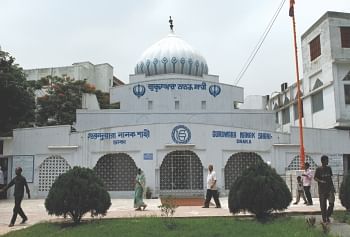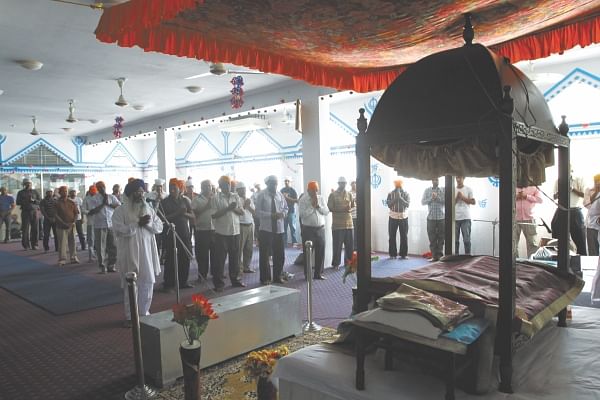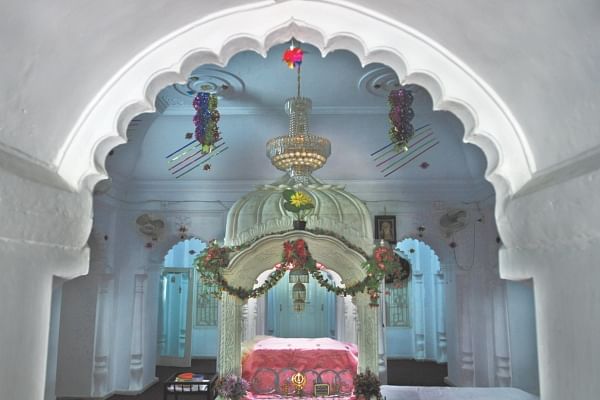| Home - Back Issues - The Team - Contact Us |
 |
| Volume 11 |Issue 27| July 07, 2012 | |
|
|
Heritage Prayers from Punjab Samira Sadeque
On a hot Friday afternoon, a temple in front of Rokeya Hall at Dhaka University awaits its devotees. Tucked in this corner of the city and painted in brilliant white, stands one of the five Sikh temples, or Gurdwaras of Bangladesh. It is a two-storied building, recently been renovated; and hosts about 250 devotees every Friday afternoon for prayers followed by a delicious vegetarian lunch. The gates remain wide open for the devotees to come in. The entrance to the temple is a narrow passage, leading up to the prayer mantle where the Gurugeranth Sahib, a holy book for the Sikh, rests. The passage along with the book is visible from the entrance, where the devotees must touch the ground before they go in. Other rituals include keeping the women's head covered, and washing one's hands before stepping in. Set within a canopy adorned with flowers, golden banners, and glitters, the Gurugeranth Sahib stands right in the centre of the temple. Inside, it is cool and bright, with the small pillars and intricately designed windows generating a feeling of tranquility. The second floor has the main prayer room where the devotees sit every Friday afternoon, and the priest leads the session. He sits in the front with a few others who help to complete the prayer session with different musical instruments. Men and women sit on different sides of the room during the prayer. For bigger events, the second floor has a larger hall, constructed recently, which hosts about 700 guests. “Sikhism, as a religion preaches peace and harmony, and encourages tolerance to other religious beliefs and practices,” says Suresh Kumar Singh, President of the Gurdwara Management Committee Bangladesh. The religion developed in Bangladesh during the early 16th century when the very first Guru, Gurunanak Devji lived here. He came here and created the Balmiki Samaj – a community which practices the ideals of Sikhism and promotes respect for other religions. Members of the Balmiki Samaj are well versed in Punjabi and are active participants at the Gurdwaras in Bangladesh today.
Singh further mentions that since the emergence of Sikhism in Bangladesh, 10 Gurus have lived in the country. Gurunanak Devji, the very first Guru back in 1503, and Guru Teg Bahadurji, the ninth Guru, lived in the other Gurdwara temple in Old Dhaka which is about 400 years old. The five Gurdwaras are spread across Dhaka and Chittagong. The Gurdwara Management Committee Bangladesh previously owned many properties such as the Ramna Park. “Due to the fading Sikh population, we have lost those properties to Dhaka University and other institutions,” says Singh, who has been here for 18 years and has devoted all his time taking care of the Gurdwaras in the country. The religion also practices a morning and evening prayer. The Friday prayers, known as Langar, which this Gurdwara hosts, last for an hour. The Gurdwara operates on donations and fees collected from members of the Indian community. The meal for 300 people each Friday costs Tk 7,000 - paid by one of the members of the volunteers’ group. Although the Sikh population in Bangladesh is quite small, the Gurdwaras always have visitors from other religious practices. The Gurdwara in Dhaka celebrates three events during the year. Their first celebration, Lohri Day, is held on January 13 and is known as the “goodluck” day in Punjabi culture. For this, the Indian community comes together and enjoys an evening filled with prayers, fireworks and food. For Besakhi, which takes place on the Punjabi calendar during the same time as the Bengali New Year, the committee arranges a festival in April. This festival welcomes people from all religious practices and hosts about a 1000 guests each year. The third festival celebrated by the Gurdwara takes place in November, to honour the first Guru's birthday. The Sikh community in the country is limited to seven priests, and a few commoners who work in the garment factories and rolling mills. Although the Sikh population is declining in Bangladesh, being a minority has never been a challenge, says Singh. |
||||
Copyright
(R) thedailystar.net 2012 |


